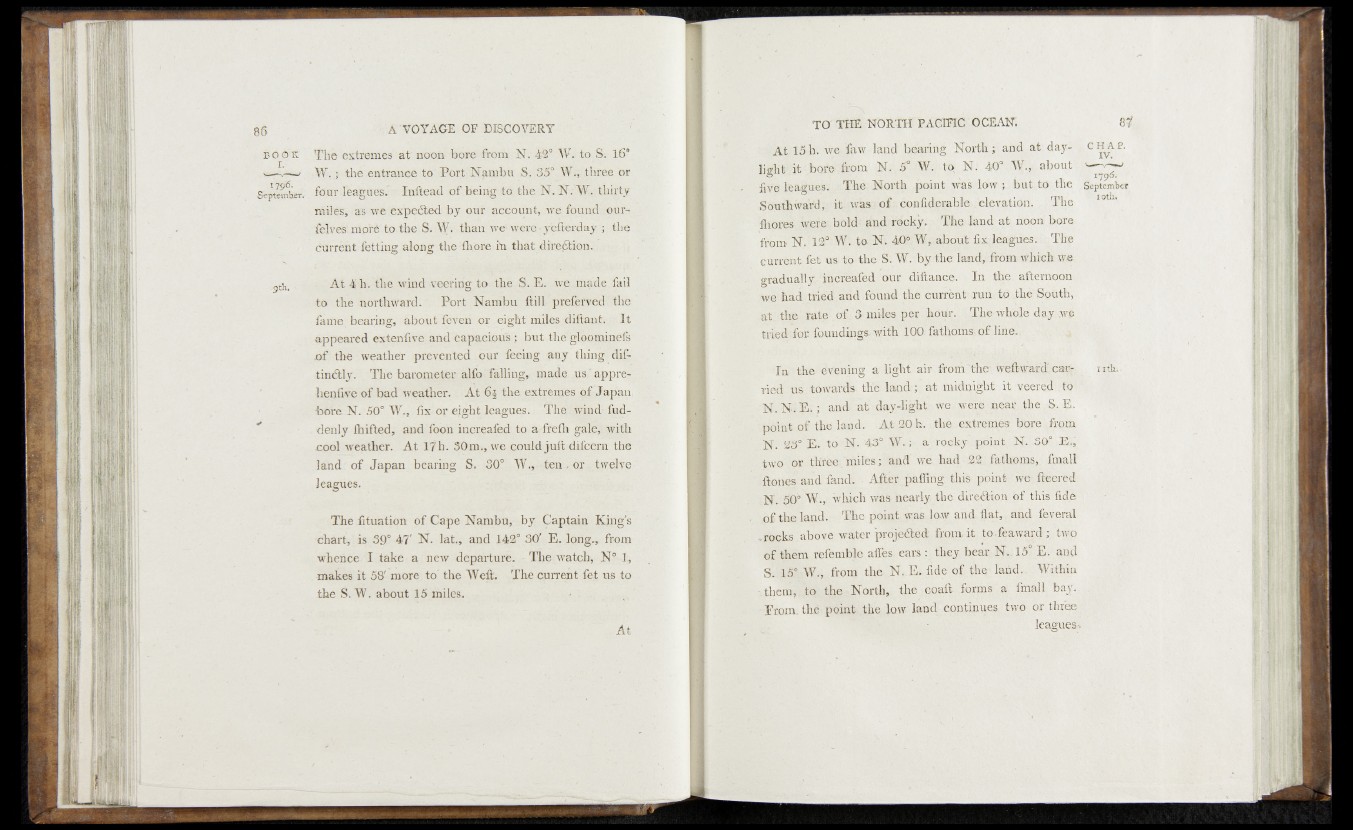
i
boq:k The extremes at' noon bore from N. 42° W. to S. 16*
v—C—' W, ;• the entrance to Port Nambu S. 35° W., .three or
•September. foor Teagues." Inftead of being to the N. N. W. thirty
miles, as we expected by our account, we found our-
felveS1 mprC to the S. W. than we' were - ypfterday,; the
current fetting along the fliore hi that direction.
At 4' h. the wind veering to the S. E. we made fail
to the northward. Port Nambu ftill preferved the
fame bearing, about feven or eight miles diftan t. It
appeared extenfive and capacious; but the gloominefs
o f the weather prevented bur feeing any thing dif-
tinétly. The barometer alfo falling, made us,'apprer
henfive of bad weather. At 6§ the extremes pf Japan,
bctê-N. A0° W., fix^ojgeight leagues. The wind fud-
, rienly Ihifted, and foon increafed to afrefh gale,! with
cool weather. At 17 h. 30m., we could juft difcQrn the
land' of Japan bearing S. 30° W., -ten , or jj twelve
leagues.
The fituation of Cape Nambu, by Captain King's
chart, is 39° 47' N. lat., and 142° 30' E. long., from
whence I take a new departure. The watch, N° 1,
makes it 58' more to’ the Weft. The current fet us to
the S. W. about 15 miles. -
At
At 15h. we faw land hearing North; and at day- CHAP,
light it< bore from N..5° W. to N. 40° W., about -— ^
five leagues. The North point wasiow > but to the, .September
Southward, it w^sj o f . conftderabls^felevation. The ' 1
fhores were- bold* and rocky. The land at noon bore
from NVl2° W. to N. 405.W, about fixjeagues. The
current fet us to the S. W. hy the land, from which Wo
gradual! v J increafed our diftance. , In the afternoon.. _ O ..." • y. / 1, x '.r '. _ ' ;■ ’' _ -
We had tried and .found the current-run to th e Sputh,
,at the rate of 3 miles per hour. Thewhole day we
tried for foundings, with 100, fathoms? of line..
In the evening a light air from 'the weft-ward; ca^ nth.
ried us.towards the land; at midnight it veered to
'N.-Nï E. ; and a t day-light - we,' were near the S. Ei *
point of the land. At 20 h. thé-extremêsf bore .from
N.' 28° E. to N. '43b W .; a rocky point N. 30° E.,
two or three, miles-; and we had 22. fathoms, final!
ft ones-and land. After paffing this point we- fteered
N 5®*” W., which was> nearly?the ditb^iph bf 'tnif fidè j
of the land.* The point was law and- flat, and feveral
.rocks above waiter projected from it to.feawa.rd; two
of them refemble affes. ears : they, bear N.: 15° E. and
S. 15° W., from the N..E. fide of the- land.. Within
■ them, to the North, the epaft. forms a fmall bay. ..
Emm. the point.,the. low land continues two or three
I v s* leagues-.